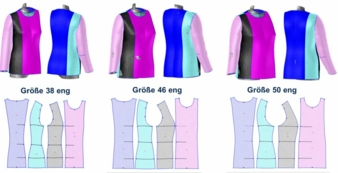16/11/2017 – TU Dresden — auf Deutsch lesen
3D product development for body-remote apparel
Researchers and commercial suppliers around the world are aiming to make the design of apparel easier ..
.. by creating a computational connection to the virtual body with a view to cutting costs in the long run. At present, the objective is not so much to transfer the entire pattern making process into a 3D development environment but to create basic 3D designs that offer excellent fit thanks to the precise size- and body-shape-specific construction and morphological grading (automatic size change in 3D). Following the computer-aided derivation of 2D pattern pieces, the latter can be made available to create fashionable adaptations for industrial scale production.
Whereas models in the basic sizes (e.g. in womenswear, sizes 38 and 46) are frequently designed with a high rate of success, there is a significant rise in the level of uncertainty and the number of required iteration loops in the size sets that are derived from gradation and are required to cover the diversity of sizes and body shapes. Given the enormous time pressure development departments find themselves under on a daily basis, it is not unusual for just a handful of sizes to be checked for fit, using prototypes and live models. Poor fit, unhappy customers and a high rate of returns (40 % to 70 %) are the unfortunate result.
3D designs for womenswear
When creating the basic 3D designs for womenswear, it is necessary to develop variable virtual bodies that allow for scaling to height and body shape. The foundation for this are the average body models in sizes 38, 42, 46, 50 and 54, which were derived from scanned data. This data is provided as triangulated surfaces and does not lend itself to automatic scaling and design-based applications in CAD systems. Indeed, they require spline surfaces generated from a defined number of slices along vertical and horizontal planes.
The feature points on the body that serve to determine the body measurement lines (chest, waist measurement, …) or lengths (shoulder width, …), can be used for the positioning of the sectional planes. If these are insufficient, additional curves are calculated that allow the body shape to be reflected with a high degree of precision by the spline surfaces. The intersection points of these lines are saved in a database for size-specific scaling in x, y, z coordinates, so that scaling may occur automatically. By linking the CAD data to an Excel sheet, on which the points information is saved, it is thus possible to take one size and generate a different size at the push of a button.
Developing the construction method
The development of the basic 3D design for the torso (blouses, jackets, …) is based on the geometric data of the virtual body which is scalable to a specific size. To create a morphologically gradable basic 3D pattern, the lines relevant to scaling and design are determined and the distances to the body are identified. The surfaces of the clothing form are depicted by free-form surfaces. They can be generated with 3D CAD software (e.g. Lectra, DesignConcept) on the basis of the curve construction. The edges of the pattern pieces are then interactively drawn onto the shape of the clothing form. It is easy to learn how to use the required drawing tools without having an in-depth knowledge of all the 3D CAD tools available on the software. Pattern designs for different product groups can be derived by modifying widths and modelling the basic construction.
The 2D pattern pieces are calculated for the desired body sizes without the usual 2D grading on the basis of body-shape data, corresponding to 3D morphological grading. For the processing of free-form surfaces (shell of the garment), suitable mathematical algorithms are provided in the software. All the relevant body measurements and feature points can be automatically projected onto each pattern piece. Even markers that are required for the subsequent sewing process can already be defined in 3D.
The morphological grading is based on the assumption that the distance between body and garment is almost the same for all sizes. When checking the fit, a modification of the respective sizes can be carried out interactively and at any time using the stored parameters. The designs for the torso and sleeves are created, scaled and checked for fit in separate modules. As a result, the dependencies between the armhole curves and the sleeve curves have to be defined and positioned with precision.
By using a scalable virtual body, the construction of the garment shell and the pattern pieces only has to be carried out the once. If the virtual body size is changed, the virtual garment will automatically adapt. Based on the basic patterns created, the garment models were developed and produced in various configurations and subsequently checked in terms of their fit, bagging and appearance. The expert assessment of the test series showed that the systematics used can also be transferred successfully to different materials. A major benefit of the research results was that 3D body data was channelled into the product development without the clothing manufacturers having to switch to a 3D development environment. This can make a significant contribution to improving the reliability of fit and to accelerating the development process.
The IGF Project no. 18223 BG / 2 was conducted by Forschungsvereinigung Forschungskuratorium Textil e.V., Reinhardtstraße 12-14, 10117 Berlin, and was sponsored through the German Federation of Industrial Research Associations (AiF) as part of the Programme for the Promotion of Industrial Collective Research and Development (IGF) by the Federal Ministry for Economic Affairs and Energy following a resolution by the German Bundestag.
by Sybille Krzywinski, Jana Siegmund, TU Dresden, Institut für Textilmaschinen und Textile Hochleistungswerkstofftechnik




